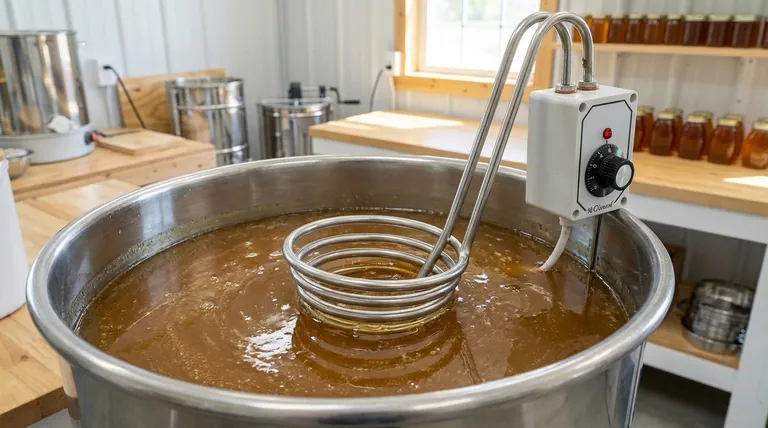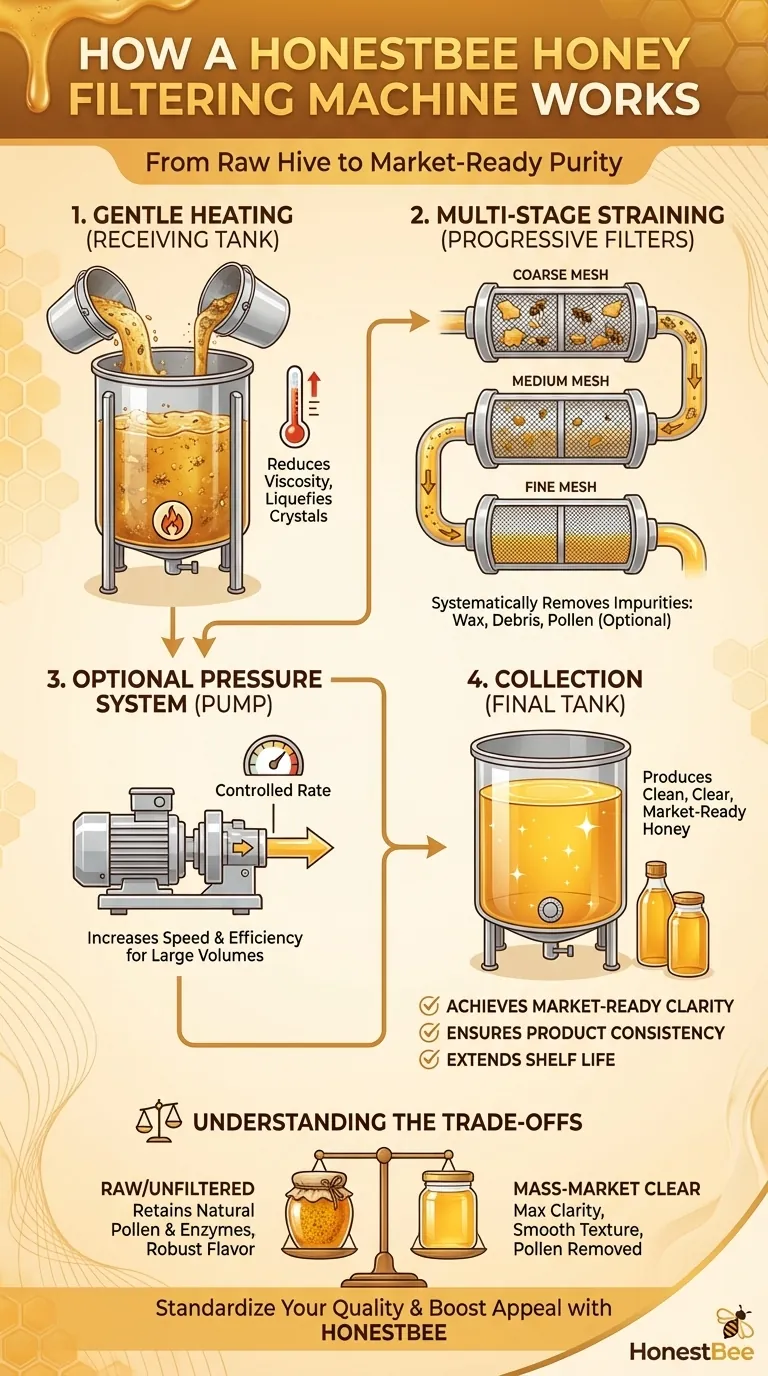In essence, a honey filtering machine works by gently heating raw honey to reduce its viscosity and then passing it through a series of progressively finer mesh screens. This process systematically removes physical impurities such as wax particles, bee parts, and other debris, resulting in a clear, clean honey that is ready for bottling and sale.
The core function of a honey filtering machine is not just to clean honey, but to standardize its quality for the market. It's a tool for transforming raw, variable honey into a consistent, visually appealing product by controlling clarity and texture.

The Core Filtration Process: A Step-by-Step Breakdown
A honey filtering machine automates and refines what beekeepers have traditionally done by hand. The goal is to produce a pure, liquid honey free from the natural debris of the hive.
Step 1: Gentle Heating for Flow
The first step is to pour the harvested honey into a receiving tank. This tank often includes a gentle heating element.
This is not for cooking the honey, but to liquefy any sugar crystals that have formed and to slightly reduce the honey's natural thickness. This makes the honey flow much more easily through the filters.
Step 2: Multi-Stage Straining
Once warmed, the honey is moved through a series of filters or mesh screens.
These screens are arranged in a progressively finer sequence. The first screen might catch large pieces of wax, while subsequent, tighter screens trap smaller particles like pollen grains or other fine debris.
Step 3: Optional Pressure Systems
To improve efficiency, some advanced machines use pressure systems.
A pump forces the honey through the filters at a controlled rate. This speeds up the entire process, which is especially valuable for larger commercial operations processing significant volumes of honey.
Step 4: Collection of Purified Honey
After passing through the final, finest filter, the honey emerges clean and clear. It flows into a final collection tank, now free of solid impurities and ready for bottling.
Why Filtration is a Critical Step
Filtering does more than just remove bee wings and wax. It fundamentally changes the product's characteristics to meet market expectations.
Achieving Market-Ready Clarity
The primary driver for filtration is aesthetics. Consumers associate clarity with purity.
Filtering removes suspended particles and microscopic sugar crystals that can cause honey to appear cloudy or grainy. A clear, sparkling honey has a higher perceived quality on the shelf.
Ensuring Product Consistency
Filtration helps create a uniform product. It removes random debris and air bubbles, ensuring every jar has the same smooth texture and appearance. This consistency is crucial for building a reliable brand.
Extending Shelf Life
By removing impurities and potential nucleation points for crystallization, filtration can help prolong the time honey remains in a liquid state. This contributes to a longer, more stable shelf life.
Understanding the Trade-offs: Clarity vs. "Raw" Honey
While filtration produces a beautiful product, it's essential to understand what can be lost in the process. The choice of how much to filter is a significant decision for any beekeeper.
The Cost of Purity: Pollen Removal
Very fine filters, often used in large-scale industrial processing, can remove beneficial pollen grains.
Many consumers specifically seek out "raw" or "unfiltered" honey because they value the presence of local pollen. Aggressive filtration removes this key differentiator.
The Power of Customization
Most honey filtering machines allow for customization. Beekeepers can swap out filter screens with different mesh sizes.
This allows them to precisely control the level of filtration, striking a balance between removing unwanted debris and retaining desirable elements like pollen.
The Impact on Flavor and Texture
Minimal straining (using a coarse filter) removes only the largest debris, leaving a product closer to its state in the hive. This honey may be cloudier and crystallize faster but is often considered to have a more robust and complex flavor profile.
Making the Right Choice for Your Honey
Your approach to filtration should be dictated by your end goal and your target customer. There is no single "best" method; there is only the right method for your specific product.
- If your primary focus is a crystal-clear product for mass-market appeal: Use a system with multiple, progressively finer filters to remove all visible particles.
- If your primary focus is selling "raw" or "unfiltered" honey: Use only a coarse strainer to remove the largest debris while retaining all-natural pollen and enzymes.
- If your primary focus is a balance of cleanliness and natural character: Use a medium-mesh filter that removes noticeable impurities but leaves much of the pollen intact.
Ultimately, understanding how a honey filtering machine works empowers you to produce a product that perfectly aligns with your goals.
Summary Table:
| Stage | Key Action | Purpose |
|---|---|---|
| 1. Gentle Heating | Warms honey in a receiving tank. | Reduces viscosity, liquefies sugar crystals for easier flow. |
| 2. Multi-Stage Straining | Passes honey through progressively finer mesh screens. | Systematically removes wax, bee parts, and fine debris. |
| 3. Optional Pressure | Uses a pump to force honey through filters. | Increases processing speed and efficiency for large volumes. |
| 4. Collection | Gathers purified honey in a final tank. | Produces clear, clean honey ready for bottling and sale. |
Ready to standardize your honey quality and boost your brand's market appeal?
At HONESTBEE, we supply commercial apiaries and beekeeping equipment distributors with robust, high-efficiency honey filtering machines designed for wholesale operations. Our equipment helps you achieve the perfect balance of clarity, purity, and natural character your customers demand.
Contact our experts today to find the ideal filtering solution for your production scale and brand goals.
Visual Guide

Related Products
- Professional Thermostatic Conical Honey Melter
- Pneumatic Double Nozzle Honey Filling Bottling Packaging Machine
- Honey Concentrating Vacuum Heating Thickening Machine Dehumidifier for Honey
- Electric 8 Frame Honey Spinner Extractor Equipment for Beekeeping
- 8-Frame Electric Self-Reversing Honey Extractor Spinner for Commercial Honey Extraction Equipment
People Also Ask
- Why is it important to heat honey slowly and evenly? Preserve Flavor, Nutrients & Value
- What are the negative effects of overheating honey? Preserve Your Honey's Natural Quality
- What is melter honey used for? A Low-Cost Ingredient for Bakers and Brewers
- How to permanently decrystallize honey? Embrace Its Natural State for Maximum Quality
- Is it safe to heat crystallized honey? Restore Your Honey's Liquid State Safely



















